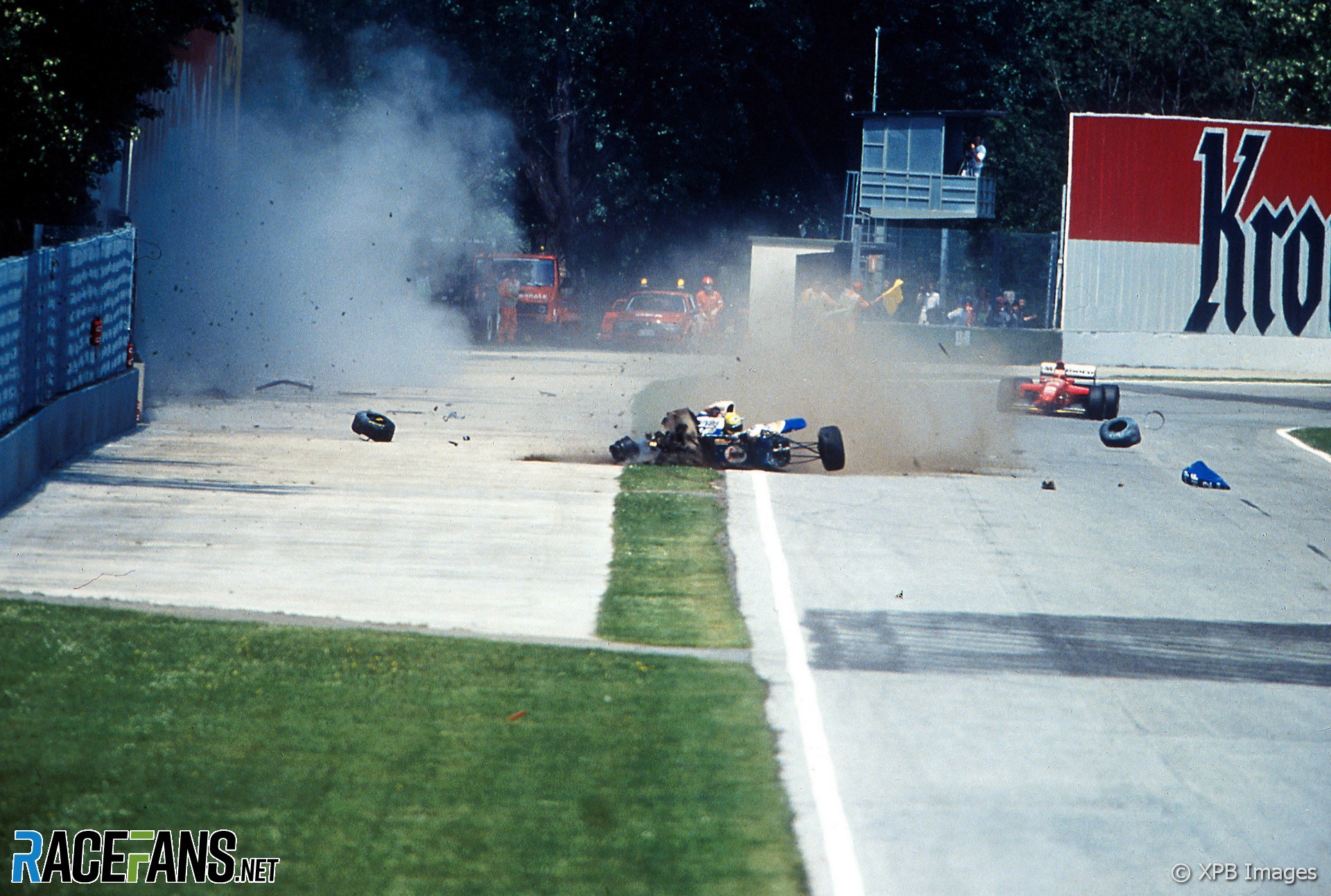The 1994 San Marino Grand Prix at Imola stands as one of the darkest weekends in Formula 1 history—a weekend that nearly destroyed the sport. The horrific events that unfolded would forever change F1’s approach to safety, and it all began with a warning that went ignored. The deaths of two drivers, Roland Ratzenberger and Ayrton Senna, highlighted a terrifying reality: Formula 1 had been playing Russian roulette at 200 mph, and the consequences of that risk-taking would soon become tragically clear.

A Dangerous Transition in Formula 1
To understand why Imola in 1994 became the site of catastrophe, one must first look at the state of Formula 1 at the time. The sport was undergoing one of its most dangerous transitions in decades. The FIA had recently banned all electronic driver aids, including traction control, active suspension, and computer-assisted systems. These changes resulted in faster, more powerful cars—700 horsepower rockets with little to no margin for error. The drivers were now testing their limits in machines that seemed to have a mind of their own, and in an environment that offered little protection from their wrath.
Amidst this chaos, two men stood at the center: Ayrton Senna, the Brazilian three-time world champion, struggling with an uncompetitive Williams, and the young German, Michael Schumacher, who was rewriting the record books with his Benetton. Their rivalry was electric, but it played out against a backdrop of cars that were becoming increasingly unpredictable.
The track at Imola, the Autodromo Enzo e Dino Ferrari, was a relic from an earlier era, one when safety concerns had not yet been prioritized. With its high-speed corners and concrete walls dangerously close to the racing line, it was a track that had barely changed since the 1960s. And yet, in 1994, it hosted some of the most advanced and perilous racing machines in history.
Friday: Barrichello’s Violent Warning
The weekend’s first major warning came during Friday practice. Rubens Barrichello, a talented Brazilian in his second F1 season, was driving his Jordan through the high-speed Variante Bassa chicane at nearly 140 mph when disaster struck. He hit a curb, launching his car into the air, sending it into the tire barriers, and flipping upside down. Barrichello was unconscious when his car came to a stop.
Miraculously, Barrichello survived, but the crash should have been a stark warning. The cars were too fast, too light, and the tracks were too old and unforgiving. The prudent decision would have been to halt the session, reassess safety measures, and possibly cancel the weekend. Instead, Formula 1 did what it always did: It kept racing. The show, as the saying goes, must go on. This decision would prove to be fatal.
Saturday: Ratzenberger’s Fatal Crash
On Saturday, during qualifying, tragedy struck again. Roland Ratzenberger, a 33-year-old Austrian rookie, was attempting to qualify for his third Grand Prix. Ratzenberger, driving for the small Simtek team, was in a battle to establish himself in F1. On his final qualifying lap, his front wing, damaged earlier, failed completely as he approached the high-speed Villeneuve corner. Without the downforce from his front wing, Ratzenberger’s car became uncontrollable, and he was unable to steer or brake. He slammed into the concrete wall at 190 mph.
The crash was horrifying and instantly fatal. Ratzenberger’s neck snapped on impact. The impact was so violent that it left his car in a motionless state, while the frantic medical team rushed to his aid, knowing it was too late. The images were captured on television for the world to see. Ayrton Senna, deeply shaken by the loss of his fellow driver, was seen openly weeping. Professor Sid Watkins, F1’s head of medical staff, recalled trying to convince Senna to retire from the sport in light of Ratzenberger’s death. But Senna, showing a tragic determination, refused to quit. “I have to go on,” he said. The race organizers, and the FIA, made the controversial decision to continue with the weekend’s events.
Senna’s Final Race Morning
The morning of race day dawned with an atmosphere of dread and sadness. Senna, visibly affected by Ratzenberger’s death, spent the morning discussing safety concerns with fellow drivers. But as the race began, Senna strapped himself into his Williams car and prepared to race. The race started with chaos: JJ Leto’s Benetton stalled on the grid, causing Pedro Lamy to slam into the rear of Leto’s car. The impact scattered debris into the grandstands, injuring several spectators and a police officer. Despite this, the race continued under a safety car.
However, the safety car used during the race was woefully inadequate. The Opel Vectra, which was employed as the pace car, couldn’t maintain the necessary speed to keep the F1 cars at proper operating temperature. The tires and brakes cooled down, making the cars even more unpredictable. Senna, growing increasingly frustrated, was leading the race when the safety car finally pulled off the track on lap 7.

Tamburello: The Moment Everything Changed
As Senna accelerated out of the Tamburello corner at nearly 190 mph, something went horribly wrong. His Williams car suddenly snapped to the right, veering uncontrollably toward the concrete wall. The impact was devastating, and a piece of the car’s suspension penetrated Senna’s helmet, killing him instantly.
The world watched in horror, unable to believe what they had just witnessed. The cameras captured everything, including the heartbreaking discovery of a small Austrian flag inside Senna’s car. Senna had planned to wave the flag in honor of Roland Ratzenberger, the driver who had died the day before. In a chilling twist of fate, Senna’s own life was claimed in the same race weekend.
The Aftermath: A Somber Podium
In the aftermath of Senna’s death, Formula 1 was in a state of shock and mourning. The race continued, but there was no celebration when the checkered flag finally waved. Michael Schumacher, who went on to win the race, stood on the podium in silence. Out of respect for the fallen drivers, no champagne was sprayed, and the drivers paid a somber tribute to their fallen comrades.
F1 had reached an existential crisis. Two drivers were dead, and the sport had just witnessed the world’s biggest star die live on television. The sport was forced to face a hard question: Could Formula 1 survive? It was a question whose answer depended on the decisions made in the days that followed.
The Safety Revolution
In the 48 hours following Senna’s death, Formula 1 began a revolutionary overhaul of its safety protocols. The FIA, finally forced to confront the consequences of its negligence, introduced immediate and sweeping changes. The Tamburello and Villeneuve corners were modified with chicanes to reduce speed. Cockpit sides were raised to better protect drivers’ heads. Wheel tethers were mandated to prevent flying debris, and crash tests became far more stringent.
But more than just the rule changes, the culture of Formula 1 shifted dramatically. The old mentality that danger was simply part of the sport was replaced by an obsessive focus on protecting drivers’ lives. Every safety innovation that followed, from the HANS device to the Halo system, can be traced back to the tragic events of Imola 1994.
The Legacy of Imola
What’s particularly painful to recognize is that none of the events at Imola were necessary. The dangers of the track were well-known, and the technology to make the sport safer had existed for years. What had been missing was the will to act. It took the deaths of Roland Ratzenberger and Ayrton Senna to force Formula 1 to prioritize driver safety over spectacle, tradition, and profit.
Today, Formula 1 is the safest it has ever been. The death of Jules Bianchi in 2015, though tragic, further accelerated the sport’s commitment to safety. Every improvement in the modern era, every piece of safety equipment, every barrier, and every medical protocol exists because of the sacrifices made at Imola in 1994.
The San Marino Grand Prix of 1994 was more than just a race. It was the moment that Formula 1 grew up. It was the moment the sport faced its own mortality and chose to value human life above everything else. It is a lesson worth remembering and a legacy worth honoring. The weekend that nearly killed Formula 1 ultimately saved it.
News
Die Welt hat sich weitergedreht: Marie Fredriksson rechnet leise ab – 5 Stars, die sie im Stich ließen.
Der Klang von Roxette war der Soundtrack einer ganzen Generation. Mit Hits wie „It Must Have Been Love“ und „The…
Conny Froboess: Die bittere Wahrheit hinter der Traumkarriere – Im Alter trägt sie eine unheilbare Wunde.
Der Name Conny Froboess ist in Deutschland untrennbar mit einem Gefühl von Leichtigkeit und sonnigen Kindertagen verbunden. Wenn ihr größter…
DER WACKELDACKEL DER REPUBLIK: WIE MERZ’ „HERBST DER REFORMEN“ IN EINER EISZEIT DER STARRE ENDETE UND UNSERE ZUKUNFT VERPFÄNDET WIRD
Einbruch in die politische Wirklichkeit: Die bittere Bilanz nach dem Versprechen des Aufbruchs Mit großen Versprechungen begann die Zeit, die…
Bommes’ Nerven liegen blank: Unerwarteter Eklat in der letzten Folge von „Gefragt – Gejagt“ schockt die Fans
Ein Augenblick, der das harmonische Ende einer Quiz-Saison sprengte. Ausgerechnet in der vorerst letzten Ausgabe der erfolgreichen ARD-Show „Gefragt –…
Herzschlag-Finale in der Scheune: Friedrich und Laura trotzen dem TV-Kitsch mit dem ehrlichsten Liebesbeweis der Staffel
Der leise Moment, der lauter spricht als jede große Inszenierung Es war der Moment, auf den Millionen von Zuschauern der…
Kai Pflaume bricht sein Schweigen: Das 30-Jahre-Geheimnis hinter Deutschlands Vorzeige-Ehe und warum seine Ilke sein wichtigstes Korrektiv ist
Die deutsche Fernsehlandschaft hat viele Gesichter, aber nur wenige sind so konstant, so sympathisch und so untrennbar mit dem Gefühl…
End of content
No more pages to load












